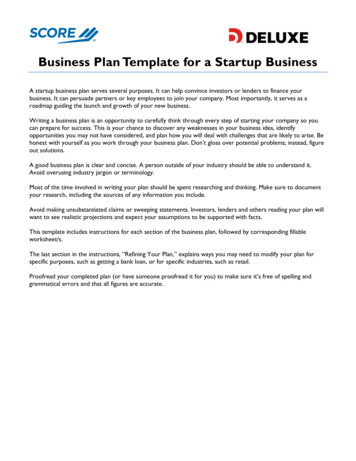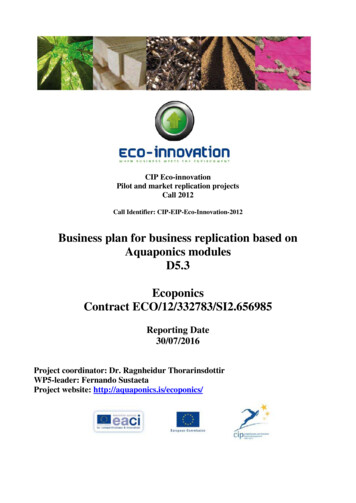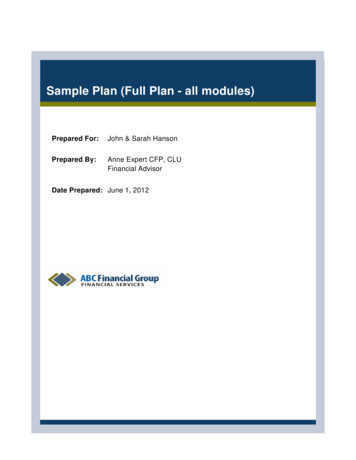
Transcription
The Business Plan
Gerald Schwetje · Sam VaseghiThe Business PlanHow to WinYour Investors’ ConfidenceWith 39 Figures and 25 Tables123
Dipl.-Kfm. Gerald SchwetjeHamburger Beratungs-Kontor GmbH & Co. KGNeue ABC-Str. 820354 HamburgGermanygschwetje@beratungs-kontor.deDr. Sam Vaseghi (Dipl. mult.)DeloitteEnvironment & SustainabilityWeidekampsgade 62300 Copenhagen SDenmarksvaseghi@deloitte.comTranslation from German by Paula and Susanne SchwetjeLibrary of Congress Control Number: 2007932195ISBN 978-3-540-25451-5 Springer Berlin Heidelberg New YorkThis work is subject to copyright. All rights are reserved, whether the whole or part of the materialis concerned, specifically the rights of translation, reprinting, reuse of illustrations, recitation,broadcasting, reproduction on microfilm or in any other way, and storage in data banks. Duplicationof this publication or parts thereof is permitted only under the provisions of the German CopyrightLaw of September 9, 1965, in its current version, and permission for use must always be obtainedfrom Springer. Violations are liable to prosecution under the German Copyright Law.Springer is a part of Springer Science Business Mediaspringer.com Springer-Verlag Berlin Heidelberg 2007The use of general descriptive names, registered names, trademarks, etc. in this publication doesnot imply, even in the absence of a specific statement, that such names are exempt from the relevantprotective laws and regulations and therefore free for general use.Production: LE-TEX Jelonek, Schmidt & Vöckler GbR, LeipzigCover-design: WMX Design GmbH, HeidelbergSPIN 1141233542/3180YL - 5 4 3 2 1 0Printed on acid-free paper
PrefaceThe business plan is a versatile means and is not only restricted to start-upsor company founders. Big companies have more or less large staff divisions which have the task of thinking about strategic questions and theirorientation in order to work out the plans for the next years.What does this look like in mid-size or small companies, which cannotafford their own staff divisions or planning departments to compile andplan their strategy. In such a case it is the manager’s or entrepreneur’s taskto develop a strategy, to define future plan data and to implement them.Many mid-size or small companies fail, because they recognize marketdevelopments too late, because they do not promote the right products, because they have not thought about certain technological processes, becausethey have not adapted their organization in time. Many reasons can benamed why such companies fail.In a successful company business and strategic situations are thoughtabout continually and decisions are made early enough in order to act successfully within the market. We believe the business plan to be a means formid-size and small companies of thinking about their company and positioning it correctly within the market. More and more do small and midsize companies also have to compete and view their markets from a globalperspective. Only someone who has prepared himself thoroughly for thisstep stands a chance within the tough competition.This book has helped many companies within the German market tothink about their company and to position it correctly. That is the reasonwhy we have decided to offer it on the international market as well. Webelieve it will encourage small and mid-size entrepreneurs to work out astrategic plan that will enable them to be successful within the market, alsowithin the global market.With this book we do not simply wish to introduce you to the theme ofdrawing up a business plan, we also wish to offer you a “book ofthoughts”, which – with all its questions – will motivate you to think aboutyour company, to write down your ideas and plans and with these to findsuitable strategies for making your company competitive.
VIPrefaceThis book could only be compiled with untiring effort of those peoplewho helped us to translate and shape it. We are particularly thankful toPaula and Susanne Schwetje who spent many hours of their free time devoting their energies to translating the book. We also wish to thank AnnaKatharina Wenzel, who gave excellent support in correcting and completing the book. Last but not least, we would like to thank our families, whogave us the time to let this book become reality.Hamburg, June 2007Kopenhagen, June 2007Gerald SchwetjeSam Vaseghi
Preface to German editionDue to the globalization of business activities and the internationalizationof the capital markets, demands on internal and external company reporting have increased, primarily the reporting of future chances and risks hastaken an outstanding position in this context. Against this background thepublicity policies of a company have to be adjusted to structure the information conveyed with financial accounting and other media in such a waythat the addressees (e.g. shareholders, investors, suppliers, creditors, employees, tax authorities, analysts, publicity) act in accordance with the setcompany goals. Thereby those responsible for such information policiesshould align their activities to the goal of increasing the company value(value reporting).In this context the business plan presents an indispensable instrument ofreporting, with which essential qualitative and quantitative company information can be documented for investors in a compact form, informationregarding existing growth or risk potentials, beyond annual financialstatement and report. The script at hand gives an extensive overview aboutthe goals, concepts and instruments of an effective business plan. Thepractise oriented remarks are supported by a multitude of illustrative examples. The drawing up, using and updating of a business plan is clarifiedwith know-how but easy language to founders of new businesses and managing directors of mid-size companies with respect to the latest knowledgein business studies.I wish the excellent handbook a high circulation and the readers successwhen realizing the recommended strategies and concepts.Hamburg, December 2003o. Univ.-Prof. Dr. Carl-Christian Freidank,Tax adviser
Table of contentsPreface . VPreface to German edition . VII1Necessity of planning . 11.11.21.31.41.52Business plan project. 92.12.22.32.42.53External use of a business plan. 11.1.1 Venture-capital financing. 21.1.2 Financing by bank credits . 21.1.3 Strategic alliances . 31.1.4 Mergers and acquisitions . 31.1.5 Customer and marketing relations . 3Internal use of the business plan. 4Basic types of business plans . 41.3.1 Short business plan. 41.3.2 Extended business plan . 51.3.3 Operational business plan . 5Why managers don’t write business plans . 5Key questions . 6Data collection. 13Initial analysis of the data. 16Partial plans . 16Financial plan and control . 17Key questions . 18Executive summary . 213.13.23.33.4Key to an effective executive summary . 22Executive summary and the business plan . 24Advantages of an executive summary. 26Key questions . 27
XTable of contents4Business idea and strategic goals. 294.14.24.34.45Management team and organization . 415.15.25.35.45.55.65.766.26.36.4Product features. 596.1.1 Unique selling propositions . 596.1.2 Auxiliary services . 60Product description. 60Product portfolio and product plan. 61Key questions . 63Market and competition. 657.17.27.37.48Operational structure . 41Organizational structure . 46Personnel planning . 50Management team . 52Reporting systems . 52Legal form . 55Key questions . 55Products and services . 596.17Business idea . 29Business model. 31Strategic goals . 334.3.1 Vision. 344.3.2 Mission. 354.3.3 Company goals. 36Key questions . 38Market . 657.1.1 Description of relevant market. 657.1.2 Market segmentation. 667.1.3 Market growth. 69Competition. 70Market position . 71Key questions . 72Marketing and sales. 758.1Marketing . 758.1.1 Marketing strategy . 758.1.2 Marketing plan . 76
Table of contents8.28.39XI8.1.3 Pricing policy . 768.1.4 Advertising and sales promotion. 798.1.5 Marketing organization . 79Sales . 808.2.1 Sales strategy . 808.2.2 Sales organization . 808.2.3 Sales plan . 82Key questions . 84Research and development . 879.19.29.3Presentation of research and development . 87Development plan. 90Key questions . 9010 Production . 9310.1 Outline of production . 9310.2 Production plan . 9510.3 Key questions . 9511 Procurement and logistics. 9911.1 Purchase . 9911.2 Logistics . 10111.3 Key questions . 10512 Finance. 10712.1 Presentation of financial situation . 10712.2 Financial data system . 10812.3 Analysis of economic development. 11012.3.1 Key questions. 11612.4 Company’s future development . 11812.4.1 Planning the sales. 11912.4.2 Cost planning . 12312.4.3 Planning the balance sheets and the P&L . 13012.4.4 Planning the cash flow . 13612.5 Sensitivity and risk analysis . 13812.5.1 Key questions. 13912.6 How finance experts rate planning . 14212.6.1 Margins . 14212.6.2 Asset management . 14212.6.3 Company valuation . 143
XIITable of contents12.7 Financing request . 14312.7.1 Key questions. 14512.8 Repayment and exit-strategy . 14513 The way to the investor . 14713.1 Planning the financial strategy . 14713.1.1 What is your company’s position?. 14813.1.2 A realistic business plan. 14813.1.3 Identifying the financing options . 14913.2 Preparing for the funding process . 15013.2.1 Presenting the organizational structure . 15013.2.2 Assessment of the business model . 15113.2.3 Validation of the financial package . 15113.3 Involve the investor . 15113.3.1 Shopping a deal. 15213.3.2 Negotiating details . 15213.3.3 “Close, collect and reflect” . 153Key performance indicators . 155List of abbreviations . 161List of figures. 163List of tables . 165Further reading. 167About the authors . 181
1Necessity of planningA business plan, in principle, can be seen as a document that commercializes your business idea as a whole towards potential investors and stakeholders. A business plan is successful if you succeed in conveying to thereader the most significant opportunities and growth capacities of yourcompany realistically.A business plan should justify and describe your business idea and further business development in a clear and adequate manner. It should notmerely aim at emphasizing the strengths of the company, but rather at presenting a realistic portrait of its problems, risks and obstacles. In additionto this, appropriate solutions should be proposed and discussed in detail.A business plan can be used for specific purposes. One target might beto obtain new means of investment for the development of a product or themarketing of a new product.Basically a successful business plan has three important features: The short- and long-term objectives are clearly depicted, a careful description is given of how the objectives can be achieved inrealistic general conditions and a description is given of how the realization of the plan will meet theexpectations of the investors.It is very important to clarify beforehand what purpose a business plan willserve and what it aims at. In general business plans are compiled either foran external or internal reason. In the following chapter we will describethese facts in more detail.1.1External use of a business planFrom an external point of view the business plan represents the main financing tool of your company. In addition, it serves to secure existing orplanned business relations between your company and your stakeholders.
21 Necessity of planningDepending on the type of financing and stakeholder relations, variousaspects are weighed up and dealt with in different ways in a business plan.1.1.1Venture-capital financingAs a rule, venture-capital and private-equity investors nowadays only consider business cases which are well represented by a business plan.When reading a business plan, the investors are primarily interested ingood and relevant arguments that promise business growth. Furthermore,investors attach great importance to how and in which period of time a return on investment will be realized, for instance: through operating profit or by going public or by merger and acquisition or through a repurchase by the management.In order to guarantee a high return on investment, investors pay great attention to: the company’s success on the market, the feasibility of the plan in order to achieve its business objectives, the unique selling proposition of the products and services and the quality and experience of the management team.1.1.2Financing by bank creditsWhen granting credits, investment banks focus on one main question:when and how the repayment of the credits and interests will be made. Inorder to minimize risks, banks usually ask for securities. That is why creditapplications addressed to banks should provide more than a list of currentand past annual accounts. Moreover, banks will also ask to what extent thecompanies are prepared for possible setbacks, and how they will be able toovercome such critical situations.For these reasons banks more and more often demand professional business plans when considering applications for credits. Banks expect business plans to give qualified insight into: the enterprise strategy, the management, the organization, the market, the competitors, the products andthe current and future financial and profit situation of the enterprise.
1.1 External use of a business plan1.1.33Strategic alliancesThe formation of strategic alliances by young and growing companieswithin the framework of research projects, product design, marketing, etc.is gaining increasingly in importance. A strategic alliance is usually theconsequence of: financial backing or access to well-established distribution channels.Such an alliance may well succeed over several years for the benefit of allparties. The majority of companies, however, request a business plan before consenting to any long-term business relations or obligations withinthe framework of a strategic alliance.1.1.4Mergers and acquisitionsAcquisitions present an alternative for company expansion, while selling acompany may be seen as the way out of a solvency crisis.Companies that are looking for acquisition candidates usually request adetailed business plan that will support their evaluation and selection of thecandidates.Similarly, the acquisition candidate himself will also be interested in thelong-term plans of any acquiring company, in order to ensure and protecthis own interests for the future. This information is also the subject-matterof a business plan.1.1.5Customer and marketing relationsWinning a major customer or an agreement with a wholesaler is a particularly crucial step towards success for many growth companies.Most big companies, however, are very reserved and precautious beforestarting negotiations with rather small and unknown companies. In suchcases, a convincing business plan may clear doubts and prove decisive forinspiring confidence, opening negotiations and making further decisions.Hence, business plans effectively help to open doors to potential customers, markets and suppliers.
41 Necessity of planning1.2Internal use of the business planA business plan also serves as a valuable management tool from an internal viewpoint of the company. A systematically elaborated and regularlyupdated business plan, with a profound insight into all business matters,helps the management to efficiently plan the company’s development andprepare the necessary modification measures in a structured way. Such abusiness plan can serve as a guide to the daily decision-making and as acontrol tool in managing the current business.The joint realization of the business plan by the management team ensures an overall commitment to the company goals and controls. Achieving this commitment on the management level is most significant for thesuccessful implementation of the plan.Business plans make a significant contribution to the development ofcompanies which have branches in different locations. By using businessplans for each branch, the top management can on the one hand guaranteesite-related business planning and on the other hand, continually controlperformance as well as the attainment of the business objectives. Furthermore, the long-term objectives of the entire company can be balanced bythese indicators.1.3Basic types of business plansFor the majority of authors writing their first business plan, the questionarises “How detailed should the business plan be?” To this question thereis, unfortunately, no standard answer and no formula.It is entirely up to you how detailed your business plan should be, anddepends solely on the purpose and necessity behind it, as well as on thecomplexity of your specific business. In general, one distinguishes between three basic types of business plans: the short business plan, the extended business plan and the operational business plan. In the following these three types are described.1.3.1Short business planA short business plan is usually about 10 to 15 pages long. It is most suitable for young companies in an early stage of their development when,there still do not exist complex interrelations.
1.4 Why managers don’t write business plans5For a well-established company, a short business plan only makes senseif certain investment opportunities are to be roughly approved in advance,in order to prepare an extended business plan on the base of the short version later on.Even if it is a “short” business plan, the required information should beconveyed in a complete and appropriate manner. The final goal is to convince potential investors that you understand your entrepreneurial businessand the market extremely well.1.3.2Extended business planThe extended business plan is usually about 20 to 40 pages long. This typeof business plan describes the business issues of the company much moreprofoundly and more detailed than a short business plan would do.The higher the required capital, the more interesting this type of business plan becomes. If, for example, you require 5 million Euros outsidecapital for the construction of a new and innovative industrial plant, i.e.you are striving for long-term credits, the preparation of an extended business plan would be advisable.Such a business plan should contain a thorough market analysis and arevenue, cost and financial planning for a 5-year period.1.3.3Operational business planFor well-established companies a business plan can serve the managementteam as an important operative tool, say a business guideline. Such a plannot only serves as a draft for the entire business organization, but also ensures a consistent appreciation on the part of the entire management withrespect to the strategic objectives. Indeed, operational business plans arevery long and detailed, usually comprising over 40 pages, in some caseseven exceeding 100 pages.1.4Why managers don’t write business plansThe increasing importance of business plans in the business environmentpossibly results in a recurring solicitude and reservation of business managers towards this topic. Moreover, in attempting to represent a complextopic by means of an exclusive business language and terminology, business plans deter many managers due to their very “academic” appearance.
61 Necessity of planningBut the aversion of many managers to business plans often is muchmore profound, namely that the description of the business objectives appears to be difficult and hardly suits their daily entrepreneurial activities.Basically, the elaboration of a business plan is a great deal of work andwould mean an additional task for the management. However, in an efficient organization, this task is based on the careful fulfilment of managerial activities that are already in progress or ones that are imminent.Managers too often argue that the development of a business plan wouldbe futile in recessionary times, since the market, i.e. the economic situation, changes rapidly and target specifications made by a business plancould be discarded overnight.From our experience, there are two important arguments against this: The whole development process of the “business plan project” is atleast just as valuable as the final “business plan document”. The“business plan project”, of course, encourages the management to reconsider and update their business objectives with the help of company-wide facts and tendencies. In addition to this, much of the information gained throughout the project (e.g. benchmarks), serves asa very valuable source for the evaluation and control of the currentand future performance of the company. The business plan should not in fact be regarded as an “untouchablecodex”, which forbids and punishes any future course deviation alonga multi-year plan. However, as a controlling tool, a business planhighlights such deviations from the planned course and also offers asensitive and flexible framework for regularly updating the facts andfigures. Such a tool allows you to quickly respond to market and economic changes in order to efficiently achieve your business goals.1.5Key questions What goals are you pursuing with your business plan? What purpose should your business plan serve? Preparation for negotiations with banks Presentation for investors As an internal management tool
1.5 Key questions7 What kind of financing are you striving for and how much capital doyou require? Which target groups and people do you want to approach by meansof your business plan? What expectations, needs and demands do your readers have? Which type of business plan will you choose and why? Are there any reasons why you would still prefer not to write a business plan?
2Business plan projectAlthough business plans vary in their structure and content, they all havesome features in common: they propose and describe business models,products or services, describe their corresponding markets, ways of production and service delivery. Indeed, external addressees of business plansusually want to know: who the shareholders are, how much capital is required, how and for what purpose capital is utilized, which type of financing will be chosen, and in what period of time an adequate return on investment can be realized.Every business plan should clearly discuss these essential issues, and present them concisely and in a convincing way. The reader should be in aposition to understand the business as a whole and to gain confidence inthe company.In order to deal with these issues in a sophisticated and professionalmanner, it is wise to draw up your business plan within the framework of acompany-wide project; this we call the “business plan project”.It is not advisable to start wr
The business plan is a versatile means and is not only restricted to start-ups or company founders. Big companies have more or less large staff divi- . Paula and Susanne Schwetje who spent many hours of their free time de-voting their energies to translating the book. We also wish to thank











